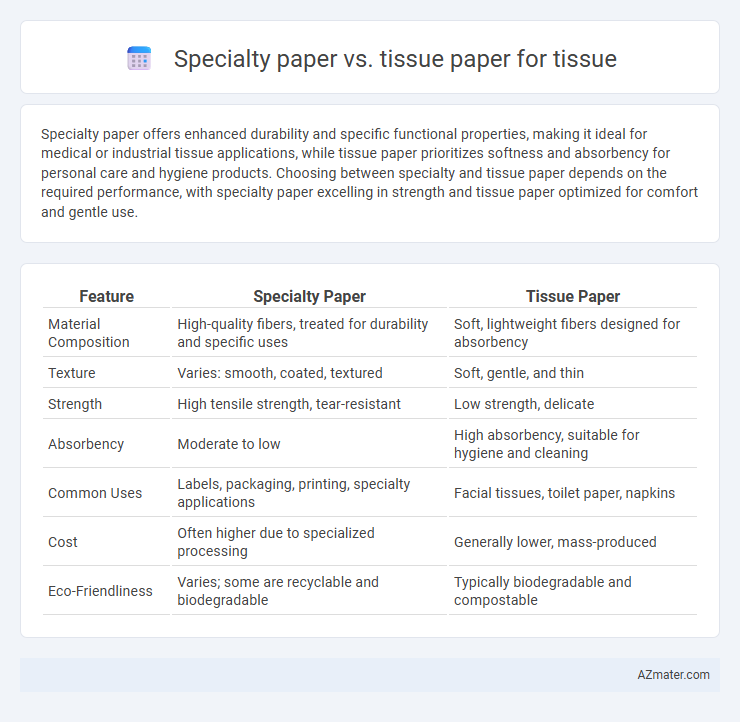Specialty paper offers enhanced durability and specific functional properties, making it ideal for medical or industrial tissue applications, while tissue paper prioritizes softness and absorbency for personal care and hygiene products. Choosing between specialty and tissue paper depends on the required performance, with specialty paper excelling in strength and tissue paper optimized for comfort and gentle use.
Table of Comparison
| Feature | Specialty Paper | Tissue Paper |
|---|---|---|
| Material Composition | High-quality fibers, treated for durability and specific uses | Soft, lightweight fibers designed for absorbency |
| Texture | Varies: smooth, coated, textured | Soft, gentle, and thin |
| Strength | High tensile strength, tear-resistant | Low strength, delicate |
| Absorbency | Moderate to low | High absorbency, suitable for hygiene and cleaning |
| Common Uses | Labels, packaging, printing, specialty applications | Facial tissues, toilet paper, napkins |
| Cost | Often higher due to specialized processing | Generally lower, mass-produced |
| Eco-Friendliness | Varies; some are recyclable and biodegradable | Typically biodegradable and compostable |
Understanding Specialty Paper and Tissue Paper
Specialty paper includes unique textures, coatings, or materials designed for specific applications like printing or packaging, offering durability and aesthetic versatility. Tissue paper is thin, soft, and highly absorbent, primarily used for hygiene products, facial tissues, and delicate wrapping. Distinguishing factors lie in their composition and functionality: specialty paper emphasizes strength and customization, whereas tissue paper prioritizes softness and disposability.
Key Differences in Material Composition
Specialty paper is typically composed of thicker fibers and may include additives for enhanced strength, durability, and unique surface properties, making it suitable for specific industrial or artistic applications. Tissue paper consists primarily of lightweight, thin cellulose fibers that provide softness, flexibility, and absorbency, ideal for hygiene and cosmetic uses. The key difference lies in fiber density and treatment, with specialty paper engineered for robustness and tissue paper optimized for gentle texture and absorbency.
Manufacturing Processes Compared
Specialty paper and tissue paper manufacturing processes differ significantly in pulp preparation and drying techniques, affecting their final texture and strength. Specialty paper production often involves chemical pulping with additives for enhanced durability, followed by calendaring to achieve a smooth surface, whereas tissue paper uses mechanical pulping and creping to create a soft, absorbent, and lightweight sheet. Advanced control of fiber composition and refining in specialty paper manufacturing ensures precise thickness and performance, while tissue paper prioritizes flexibility and softness through controlled drying and creping stages.
Strength and Durability Analysis
Specialty paper offers enhanced strength and durability due to its engineered fiber composition and advanced manufacturing processes, making it suitable for heavy-duty applications compared to standard tissue paper. Tissue paper, typically made from softer, thinner fibers, provides limited tensile strength and durability, prioritizing softness and absorbency over robustness. In strength and durability analysis, specialty paper consistently outperforms tissue paper by maintaining structural integrity under stress and prolonged use.
Absorbency and Softness Evaluation
Specialty paper designed for tissue applications typically offers enhanced absorbency due to a higher density of cellulose fibers and optimized pore structure, ensuring superior liquid retention compared to standard tissue paper. Softness evaluation reveals that tissue paper formulated with finer fibers and advanced creping techniques provides a gentler touch suitable for sensitive skin. Testing metrics such as water holding capacity and surface roughness confirm that specialty tissue grades outperform conventional tissue papers in both absorbency and softness.
Cost Considerations and Pricing
Specialty paper generally incurs higher costs than tissue paper due to advanced manufacturing processes and enhanced material properties tailored for specific applications. Tissue paper offers a more cost-effective option for mass-produced products, making it ideal for disposable hygiene items and packaging. Pricing differences are influenced by factors such as basis weight, ply count, and added functional treatments in specialty papers, which elevate production expenses compared to standard tissue papers.
Environmental Impact and Sustainability
Specialty paper often involves chemical treatments and coatings that can hinder recycling processes and increase environmental pollution compared to tissue paper. Tissue paper, typically made from recycled fibers or sustainable sources like bamboo, offers a lower carbon footprint and higher biodegradability, making it more eco-friendly. Choosing tissue paper supports sustainability through reduced water usage, energy consumption, and improved waste management in production and disposal.
Applications in Tissue Production
Specialty paper in tissue production is engineered for enhanced strength, softness, and absorbency, making it ideal for premium hygiene products such as facial tissues and sanitary napkins. Tissue paper, typically lighter and more permeable, is widely used for disposable applications like toilet paper and paper towels due to its cost-efficiency and quick disintegration. Choosing between specialty and tissue paper depends on required functional properties, including durability, softness, and absorbency, tailored to specific tissue product markets.
Consumer Preferences and Market Trends
Specialty paper for tissue products appeals to consumers seeking enhanced durability, absorbency, and unique textures, driving demand in premium segments. Tissue paper remains popular for everyday household use due to its softness, affordability, and biodegradability, reflecting sustainability trends influencing purchase decisions. Market trends show increasing consumer preference for eco-friendly and functional specialty papers, prompting manufacturers to innovate with recycled fibers and sustainable production methods.
Choosing the Right Paper for Tissue Needs
Specialty paper offers enhanced durability and specific functional properties, making it ideal for medical or industrial tissue applications, while tissue paper provides softness and absorbency suitable for personal hygiene and facial tissues. Selecting the right paper depends on the intended use, desired texture, and strength requirements to ensure performance and comfort. Evaluating factors such as ply count, fiber composition, and absorbency rates helps match tissue products to consumer needs effectively.

Infographic: Specialty paper vs Tissue paper for Tissue
 azmater.com
azmater.com